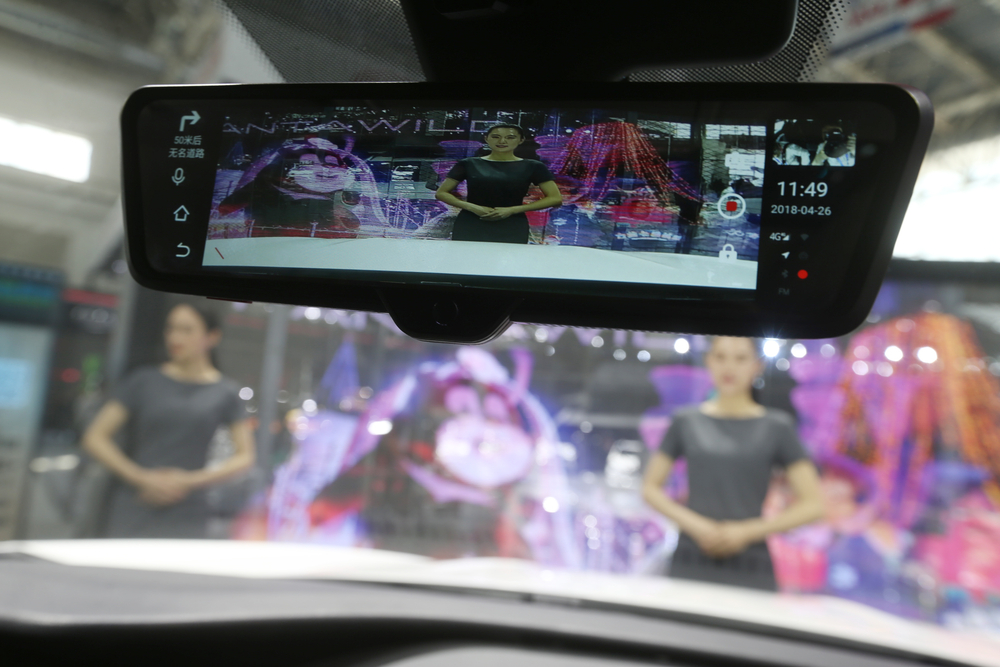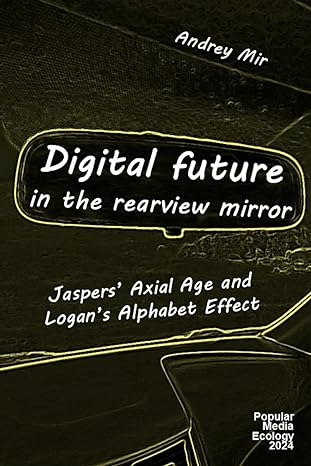Mir McLuhanism
By Arnold Kling


- … digital media not only enhance information exchange and render offline life obsolete—they also reverse literacy and retrieve orality.
- … This book is about orality, which once was obsolesced by writing, and about literacy, which is now becoming obsolesced by digital media.
- —Andrey Mir, Digital Future in the Rearview Mirror: Jaspers’ Axial Age and Logan’s Alphabet Effect,1 (p. 10)
In high school, there was an avant garde English teacher who introduced us to Marshall McLuhan, known for his catch-phrase “the medium is the message.” My cynicism about Sesame Street was based on McLuhan’s insistence that the nature of the medium would have a stronger effect than its content.
Andrey Mir refers to McLuhan and his fellow travelers as media ecologists. In addition to McLuhan, he cites Eric Havelock, Harold Innis, Jack Goody, Walter Ong, Neil Postman, and others.
Mir argues that media ecology explains many of the cultural changes that we are experiencing. Many of us would say that we are suffering through these cultural changes, as Enlightenment values of free speech, objective inquiry, and dignity of the individual seem to be slipping away.
Mir writes,
- Why do people on social media become so polarized and deaf to logic and reason? Why do people read less and demand more? How do social media change minds and society? What comes next? The answer is digital orality. (p. 14)
Mir sees the invention of alphabetic writing as a useful “rearview mirror” for grounding his analysis. Following Robert Logan, Mir sees alphabetic writing as wiring minds for intense concentration and for abstraction. Mir argues that alphabetic writing therefore created the conditions for the cultural changes that Karl Jaspers termed the “Axial Age.” The Axial Age, around 500 BC, is when humans began to see themselves in relation to history and to an all-powerful deity. Our notions of scholarship, argumentation, empirical observation, and logic all appeared during the Axial age.
Consider the changes that took place as humans went from having only face-to-face oral communication to having the ability to read and write. Writing gives us a powerful form of social memory, reducing our need to rely on individual memory. Preliterate man lives in a multi-sensory present. For literate people, a more introverted existence becomes possible. As we read, we tune out the world in order to focus on input from our visual sense. We can detach from the present to dwell in the past and the future. Instead of relying on our instant reactions, we stop to reflect and think about what we read. We relate to descriptions of people and events that are outside of our personal experience.
Reading requires us to think abstractly. This is particularly true of alphabetic writing. The meaning of the symbols on a page is not self-explanatory. We have to interpret and calculate meaning.
When only oral communication is available, collective memory must be in the form of received wisdom. We value the person who can repeat with high fidelity the sacred stories. With writing, there is room for thinking. We can value the person who asks questions or who criticizes.
Writing allowed for the codification of laws, eventually leading to impersonal concepts of justice. Printing, which came after Gutenberg, allowed wide reproduction of thought, which in turn made possible the scientific method of testing for reproducibility of results.
How does the spread of electronic media, especially in the 21st century, affect our brains and our society?
Mir says that the new media put a premium on rapid reaction, not reflection. They tempt us away from contemplative reading with addictive distractions.
With the advent of cable news,
- Television stopped being news-centered and started being viewercentered. This move reversed the print-induced control over emotions and retrieved the agonistic mentality both on the air and in the viewers, starting the process of cultural and political polarization (which skyrocketed 15 years later with the advance of social media). (p. 244)
Mir claims that modern media are behind the rise of identity politics.
- Digital orality recreates an environment in which collective indoctrination is encouraged while personal inquiries are suppressed. (p. 217)
- Truth is a referendum by likes. (p. 228)
- It is becoming harder to withstand the “peer pressure” of the tribe when objective truth does not align with the truths of the tribe. (p. 235)
So where are we now? Mir remarks,
- … blog posts were the last texts of the Gutenberg era. (p. 317)
This leads me to wonder what are the demographics of the readers of Substack essays, which are reminiscent of blog posts. I worry that this readership skews over the age of 50.
- Digital speech possesses the characteristics of both oral and written communication. Similar to oral speech, it enables the instantaneous exchange of replies; akin to writing, it leaves a record behind and can be transmitted across time and space. These features imply that people’s spontaneous and mostly emotive efforts to establish their social statuses in conversation are no longer evanescent. The interactions of millions of people are accumulated, disseminated, and displayed for everyone else to react to.
- This new type of conversation has its benefits. It allows socialization at an unprecedented pace and scale. But the ease of exchanging digital speech has shifted the focus of communication from reflections to reflexes, from substance to attitude. Social media demand that everyone relate to others, to their ideas, to their troubles and achievements, to their very existence. The Viral Editor of the blogosphere has evolved into the Viral Inquisitor of social media.
- [On the Internet] authors do not share physical space and type their replies in isolation. Besides, such conversation often has more than two interlocutors, and the exchange becomes chaotic. The oral thema-rhematic reliance of replies on preceding utterances is often broken, and the written syntax does not apply either. All this makes digital conversation a weird hybrid in which interlocutors often simply do not “hear” each other. Their dialogue is not coherent; it is fragmented, causing emotional frustration, which is so typical for digital conversations.
- Moreover, since digital speech is recorded, it is not just a mere exchange; it is an exchange displayed to others who can judge and contribute. Therefore, it is an exchange aimed to affect others. The agonistic mentality of orality flourishes in digital orality and amplifies frustration and polarization even more.
(p. 318-319)
Mir goes on to say that “like” buttons, emojis, and other forms of digital communication are even more primitive than speech. They are more like grunts and gestures. He writes,
- … digital orality trains the brain to experience tiny and repetitive hormonal gratification for minuscule efforts of participation or even for simple presence. (p. 319)
And where are we headed? In only a brief section, Mir suggests that we humans are close to leaving the real world behind in order to live completely in the virtual world.
I found this prognosis, and indeed the entire book, to be intriguing, but speculative. It seems plausible that human brains and culture were affected by literacy in general and alphabetic literacy in particular in the ways that the media ecologists argue. And it is plausible that the apparent decline in support for Enlightenment modes of thought can be traced to the shift in digital media.
But the media ecologists do not subject their hypotheses to rigorous empirical tests. They do not look for natural experiments that might demonstrate that their proposed causal mechanisms are at work.
For more on these topics, see
 Russ Roberts on the Information Revolution, Politics, Yeats, and Yelling. EconTalk.
Russ Roberts on the Information Revolution, Politics, Yeats, and Yelling. EconTalk. David Weinberger on Everything is Miscellaneous and the Wonderful World of Digital Information. EconTalk.
David Weinberger on Everything is Miscellaneous and the Wonderful World of Digital Information. EconTalk. Robin Hanson on the Technological Singularity. EconTalk.
Robin Hanson on the Technological Singularity. EconTalk.- “Tribal Psychology and Political Behavior,” by Arnold Kling. Library of Economics and Liberty, Aug. 6, 2018.
Many observers have noted and lamented the shift away from objectivity in academia and journalism. Some attribute this to an ideological takeover by postmodernists and leftists—the so-called Gramscian march through the institutions. Other assign some blame to the feminization of institutions, with women bringing their social tools of enforcing conformity into campuses and newsrooms.
Even theorists such as Jonathan Haidt, who see social media as the root of much evil, point to the specific strategies and tactics employed by the leading corporations as the problem. Just as the fans of Sesame Street saw hope that television could be reformed for social good, Haidt would seem to hope that with better norms and guidelines, the harms of social media can be contained. A devotee of McLuhan would be skeptical.
Footnotes
[1] Andrey Mir, Digital Future in the Rearview Mirror: Jaspers’ Axial Age and Logan’s Alphabet Effect. Human as Media, 2023.
*Arnold Kling has a Ph.D. in economics from the Massachusetts Institute of Technology. He is the author of several books, including Crisis of Abundance: Rethinking How We Pay for Health Care; Invisible Wealth: The Hidden Story of How Markets Work; Unchecked and Unbalanced: How the Discrepancy Between Knowledge and Power Caused the Financial Crisis and Threatens Democracy; and Specialization and Trade: A Re-introduction to Economics. He contributed to EconLog from January 2003 through August 2012.
Read more of what Arnold Kling’s been reading. For more book reviews and articles by Arnold Kling, see the Archive.
